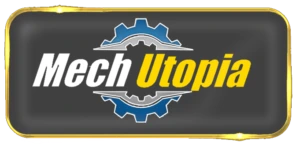1. Introduction
VMC stands short for Vertical Machining Centers, they are CNC machines where the spindle is positioned vertically. These machines also have automatic tool changers integrated with them.VMCs or Vertical Machining Centers are among the most commonly found and easily accessible machining centers in the market. Therefore, they are one of the most affordable types of machining centers which makes it a good choice for beginners and small workshop owners.
Although some of these VMC machines come with a pallet-changing feature, it’s often an additional option. This is because the tables on these machines are designed to carry heavier materials, making it challenging to change the large tables. Hence, pallet changing is an extra feature. Due to their smaller size compared to other machines, they offer tool storage options (between 30-50 tool pockets) in their magazines and simpler tool-changing systems with advanced tool probing capabilities. These machines are known in the market as affordable, reliable, and robust, accessible to all workshops.
In further sections of this article, I am going to give you more comprehensive information about Vertical Machining Centers. Also, I had previously written an article about well-known Machining Centers which you can check here. This article will focus solely on Vertical Machining Centers (VMC).
You can check this article for comprehensive information about UMC(Universal machining centers).
Please check this article for more about the HMC(Horizontal machining center).
2. History and Evolution of VMC
If we were to discuss the origins of Vertical Machining Centers, it’s evident that these machines evolved from standard conventional milling machines. For instance, a specific model from the Bridgeport Mill brand can be cited as an example.
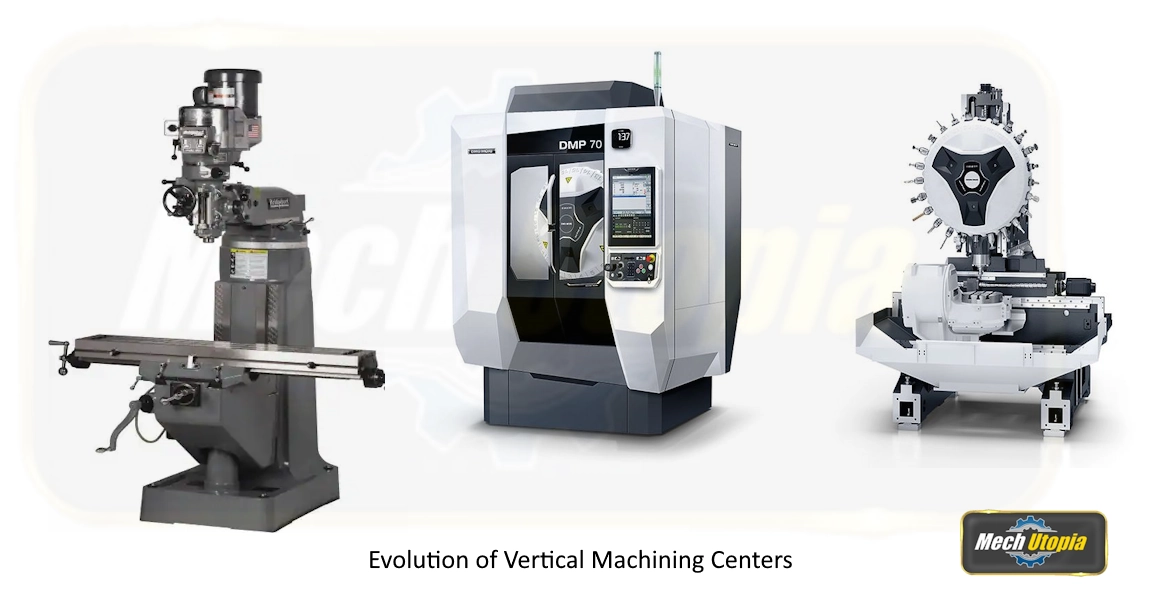
VMCs, due to their compact size, can fit most workshops easily This is making Vertical Machining Centers a popular choice for entry-level hobbyists and small business owners. Today, VMCs range from simple three-axis CNC machines to complex five-axis variants with rotary tables.
3. Basic Components of a VMC

- Mainframe and base
- Spindle and tool changer
- Worktable and fixture
- Control panel and software
a. Mainframe and base:
The structure of VMCs is straightforward. As mentioned earlier, they are derived from milling machines. This structure consists of a large main column, with moving X and Y axes and a vertically moving Z-axis. In five-axis versions, the X and Y axes table can be replaced by a cradle-style rotary table. Typically, as the distance from the machining center`s column increases, the machine’s rigidity decreases, and vice versa.
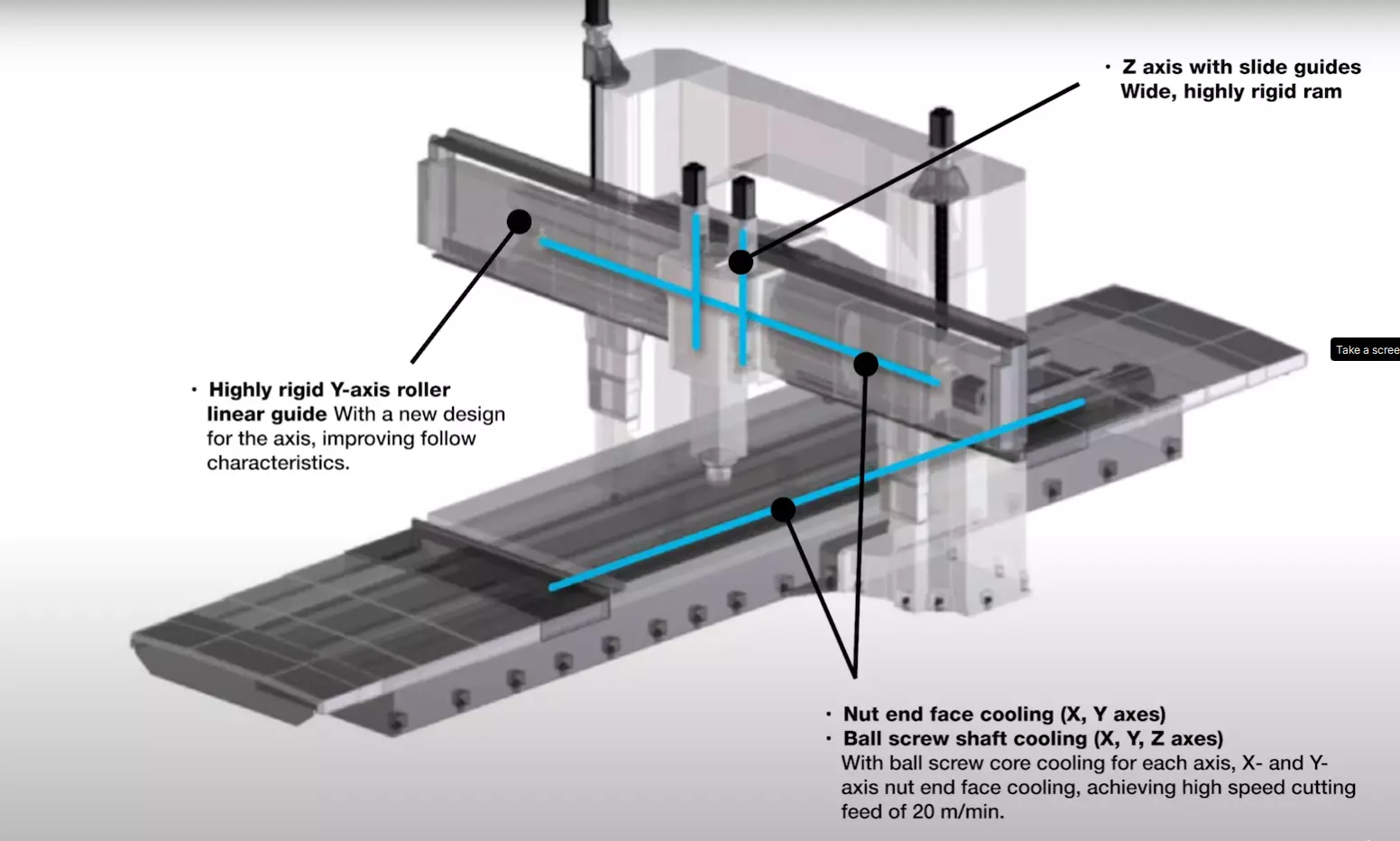
b. Spindle and tool changer:
VMCs come with spindles and automatic tool changers. The automatic tool changer automatically picks up the tool from the magazine and places it in the spindle. Before every tool changes, the spindle positions itself in a specific orientation(“M19” command commonly used for spindle positioning), ensuring consistent tool positioning, enhancing sustainability, and increasing machine productivity. Moreover, spindles can be mounted directly or indirectly to servo motors. Nowadays, thanks to internal windings, servo motors can be built directly into the spindle housing. This system, being more prevalent in high-end machines, is still not found in many machines where direct and indirect connection systems are used.
c. Worktable and fixture:
The worktable in VMCs is spacious, and since these tables are parallel to the ground, they offer a convenient working area for operators, giving a feeling of working on a table. Large materials or parts can easily be mounted on these tables, utilizing gravity. Additionally, using a vertical table can facilitate the mounting of taller parts. Another feature is the ease of adding a rotary table, enabling fourth-axis operations.
d. Control panel and software:
The digital control panel is electronically similar to other machining centers, but the software typically supports three-dimensional or 2.5D CNC controllers. Many CNC machining center manufacturers, especially for VMCs, preload auxiliary programs, allowing operators to program directly on the control panel without needing a computer setup.
4. Types of VMCs
a. Turret VMC:
Turret VMCs are among the common types of Vertical machining centers. Their primary characteristic is the turret-style tool changer and a single Z axes column they possess. Since these machines are not very complex turret automatic tool changers can be easily mounted on them. Therefore, turret tool changers pick up the tool from the machine, retract it, position it for the next tool, and then advance to replace the tool. This process takes longer than other automatic tool changers. These days arm-style and chain-style.c
b. Moving Column VMC:
Moving Column VMCs are designed with a moving column, where the Z or Y-axis is built on a bridge-like structure. The X-axis movement typically results from the movement of this large column. This design facilitates the machining of larger and longer parts, especially molds. The X-axis is usually the most extensive axis, and its movement is achieved by advancing the column itself, carrying the spindle, and sometimes even the automatic tool changer(ATC).
c. Fixed Column VMC:
Fixed-column VMCs are typically used by companies that machine large parts. This machine sits between single-column upright(Turret Style) VMC and Moving Column Machining Centers. The X-axis movement is usually very significant, but the column remains stationary(fixed), only housing the Z or Y-axis. Only the X-axis moves left and right, while the Y-axis moves on the column.

5. Advantages of Using a VMC
- Precision and accuracy: VMCs can produce more precise work with less thermal extension due to their smaller size than other machining centers.
- Flexibility in operations: The ease of mounting parts on a VMC makes it versatile for various part machining setups.
- Efficient for mass production: VMCs are ideal for mass production due to their convenient positioning. With the integration of auxiliary robotic arms and vices, parts can be automatically mounted and removed.
- Reduced manual labor: VMCs can perform many operations, reducing the workload on the operator. This has led to a decrease in the need for manual labor.
6. How VMC Differs from Other Machining Centers
a. Comparison with HMC (Horizontal Machining Center):
The closest relative to VMCs is a horizontal machining center, HMC. Compared to VMCs, HMCs have a more intricate design and larger size, leading to higher costs and a greater initial investment. Additionally, part mounting is more challenging in HMCs than in VMCs. HMCs come with more complex tool magazines and automatic pallet changers, increasing their operational complexity. In contrast, VMCs are the simplest type of machining center, making them easier to learn and operate.
b. Benefits of vertical orientation:
As previously mentioned, the vertical positioning of the machining center offers several advantages. The most significant is the ease of part mounting. Another advantage is the ease of operation; operators find it more comfortable and convenient to work on a table surface parallel to the ground. Gravity can be used to easily mount large and heavy parts on these machines.
c. When to choose VMC over other options:
One should opt for a VMC if the investment capacity is limited. If space is an issue, VMCs, due to their smaller footprint, are a more practical choice. Another reason to choose VMCs is their ease of operation and learning curve. They can be quickly set up and operated soon after purchase.
d. Disadvantages of Vertical Machining Centers
Since Vertical machining centers are designed to be perfect some challenges can be faced in some areas.
| Disadvantage | Description |
|---|---|
| Limited Part Size | VMCs have a restricted work envelope, limiting the size of parts that can be machined. |
| Chip Evacuation Challenges | The vertical position of the machine and spindle makes chip evacuation more challenging. Chips tend to sit on the bottom of the part`s machined cavities and on the table of the machine. |
| Reduced Rigidity | Vertical orientation can result in reduced machine rigidity compared to horizontal setups. Especially Turret-style single-column VMC machines can face rigidity problems. |
| Coolant Flow Issues | Ensuring proper coolant delivery in VMCs can be challenging, impacting cooling effectiveness. |
7. Practical Applications of VMC
VMCs are frequently used in the automotive industry, plastic mold and tool-making industry, sheet-metal progressive Die manufacturing industry, vacuum forming industry, and aerospace industry.
VMCs can easily machine mechanical parts, especially with vices’ ease of use and mounting. With the portable five-axis or 4-axis tables available on VMCs, they can also machine extremely complex aerospace parts. Their long size allows them to perform operations that require a significant material removal rate, like mold cavity machining.
8. Upgradable, Extra Features of VMC
Since vertical machines have many features, there is room to upgrade and adopt extra features. The 2 most common upgrades you can do for your VMC are listed below.
a. Adding a 4th & 5th axis indexable Rotary Table:
With the 4th-axis (A axis) indexable table update, you can place an angular-indexable table on top of the main table of VMC. With an angular 4th-axis table, you can rotate the part to the machine side wall`s features without dismounting the workpiece from the VMC machine. This is good for matching side walls by indexing the table at any angle. The additional fourth axis requires a servo motor, servo driver, and controller capability to operate it.
Adding a 5th-axis rotary table will allow you to machine 5-axis(A, B Axis) parts simultaneously or by just indexing the A and B axes.
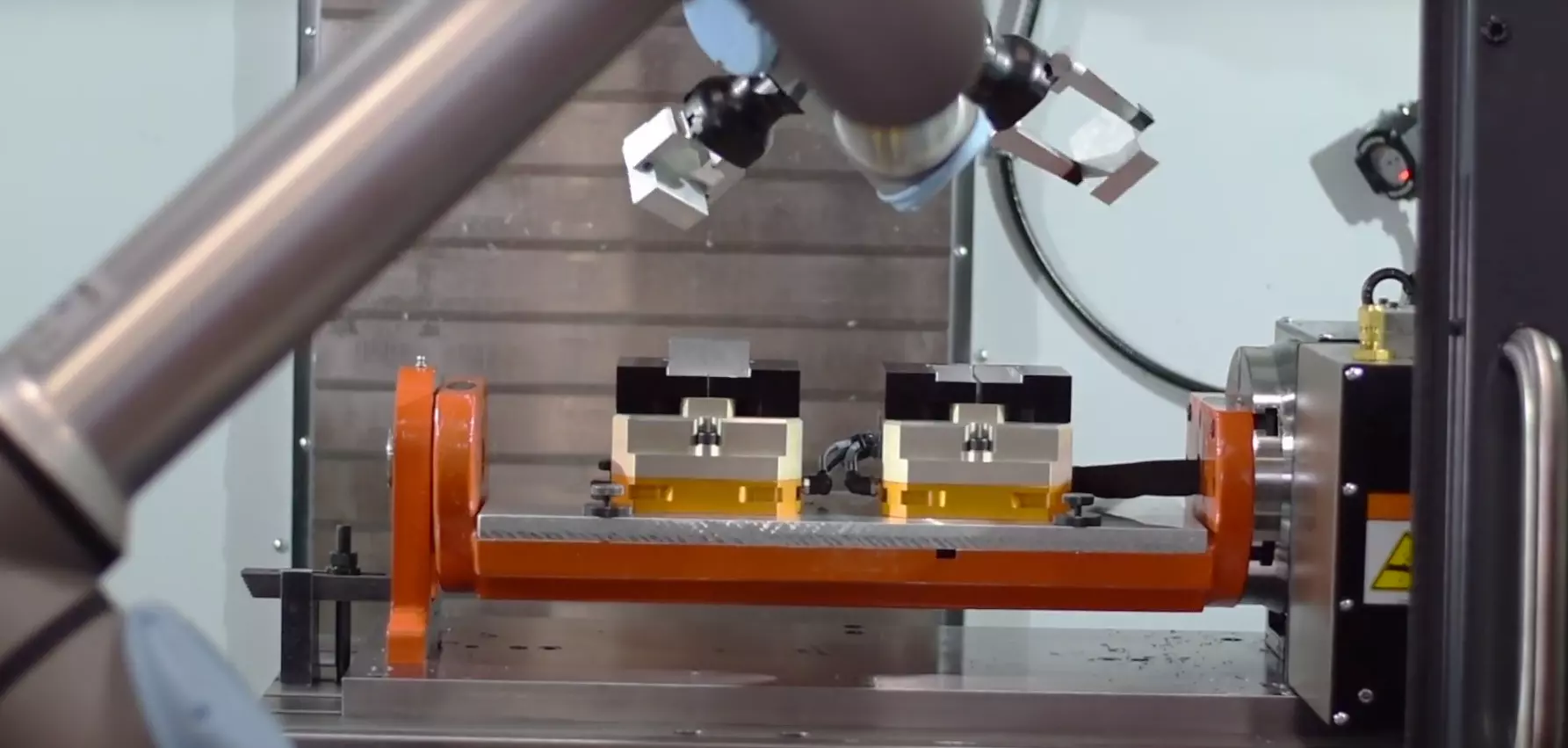
b. Upgrading to a chain-style Automatic Tool Changer (ATC)
Vertical machining centers commonly come with a turret-style magazine for automatic tool changing. Generally, it comes with around 30 pocket tool stations. Upgrading it to a chain-style automatic tool changer will double, or triple your tool storage capacity.
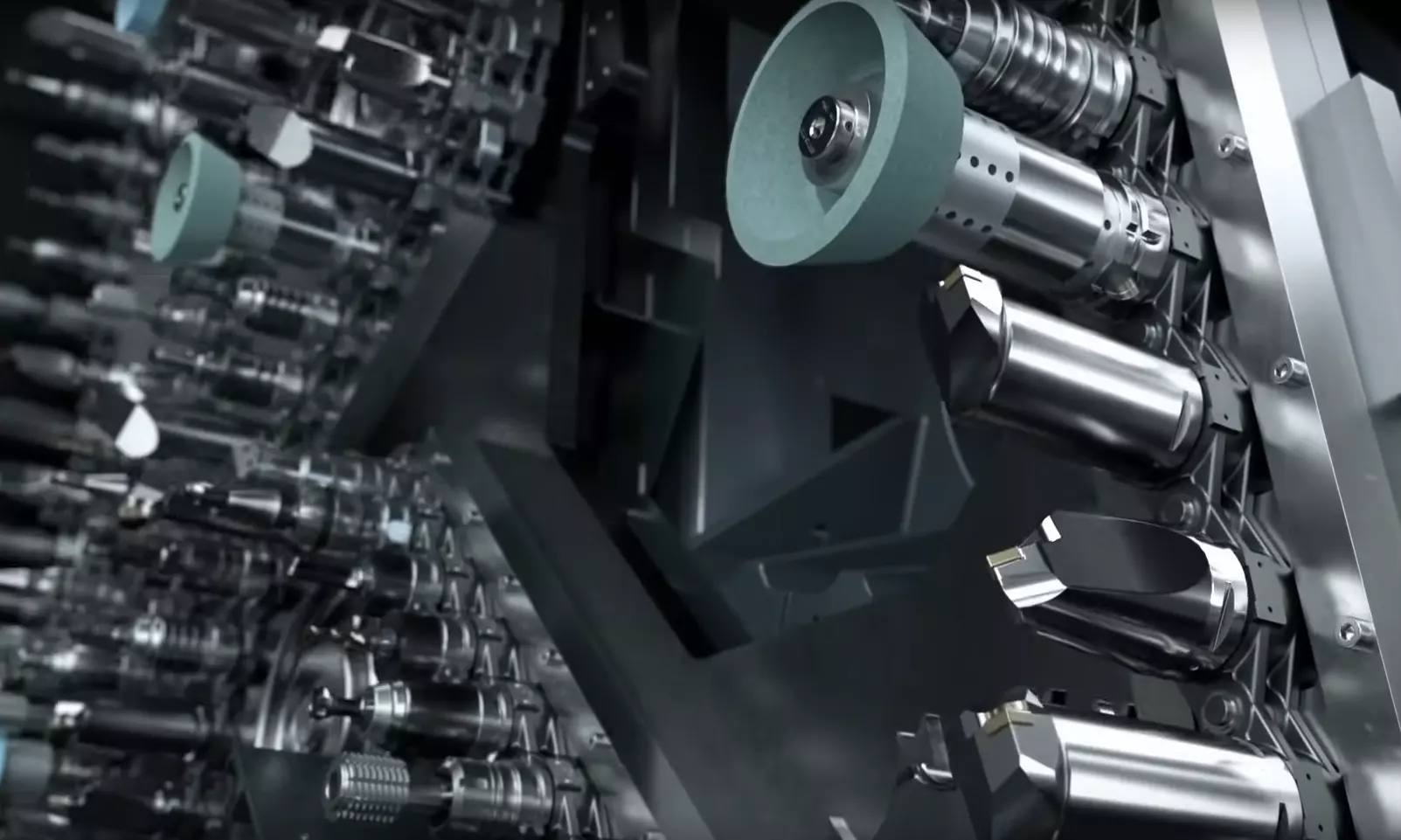
9. Tips for Beginners
Tip-1: Choosing the right VMC for specific needs. Based on my experience, I recommend beginners start with a simple three-axis VMC. Starting with this will equip you with a foundational knowledge of CNC machining and a grasp of the machine’s potential. With time and accumulated experience, transitioning to sophisticated machines becomes viable.
Tip 2: Understanding the software needs. Before purchasing a VMC, it’s essential to understand the software that comes with it. Some VMCs come with user-friendly programming software, while others may require additional training.
Tip 3:Regular maintenance. Like all machines, VMCs require regular maintenance. It’s essential to maintain the machine’s cleanliness, and regularly lubricate its moving components.
10. Conclusion
As you can see VMCs can offer very versatile machining opportunities on a smaller footprint compared to UMC and HMC. Also, it offers a cheaper CNC machine option, so it is very good for beginners.
